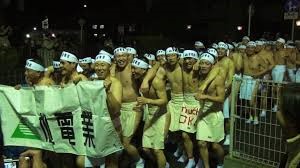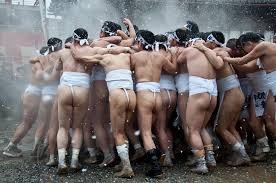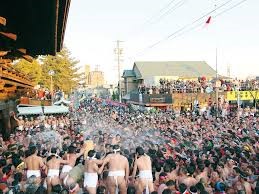During the Lunar New Year festivities, devotees and numerous men adorned in traditional loincloths assemble at the Owari Okunitama-jinja Shrine, situated in the typically serene city of Inazawa in Aichi. Their purpose is to offer prayers for favorable fortune and blessings in the upcoming year.
Celebrated as the Naked Festival, Hadaka Matsuri first gained public attention during its midnight celebration at Saidai-ji, Japan’s largest temple. This unique occasion attracts about ten thousand participants, comprising men and boys in loincloths fiercely competing for two sacred sticks. In addition to being a lively event, the festival is a symbolic attempt to ensure good fortune for the upcoming year, attracting curious onlookers who add to the lively mood of the festivities.
Every year, on the third Saturday of February, in Saidaiji-naka, Okayama, Japan, more than nine thousand men, excluding spectators, converge at Saidai-ji Temple for one of the nation’s quirkiest festivals—the ‘Naked Festival’ or Hadaka Matsuri.
Boasting a history of more than five centuries, Hadaka Matsuri originated as a competition among worshippers vying for paper tokens from Shinto priests, referred to as “go-o.” Believed to bring a year of happiness to recipients, these tokens also served as a means to ward off plagues and pestilence.

A single individual is designated as the shin-otoko (god-man) for the festival, undergoing days of seclusion and contemplation leading up to the event. Ultimately, he undergoes a complete head-to-toe shaving, and on the festival day, he emerges into the crowds completely unclothed.
Witness the spectacle as thousands of partially clad men strive to make contact with the shin-otoko, seeking to transfer their future misfortunes onto him. Finally, amid the cheers of thousands of supporters, the god-man is led into the shrine building, marking the climax of the ritual.
Hadaka Matsuri is a celebration that is limited to men. Young boys from elementary schools engage in a distinctive competition at Saidai-ji throughout the day, and older men join in the celebrations at midnight. On the other hand, places such as Konomiya don’t have age limits, so even the youngest kids can take part in the activity.
The term ‘Naked Festival’ might be misleading, since participants are not actually nude or celebrating fertility or other ideas that are commonly associated with the word “naked.” Given that the Hadaka Matsuri takes place in late autumn, as the weather cools, donning the traditional white loincloth adds an extra challenge.
Various iterations of the Hadaka Matsuri are observed throughout Japan, each featuring slight variations in activities. In the small town of Shimadachi, for instance, elementary school boys partake in a procession through the town clad in loincloths for several hours. The event concludes with a prayer at the local shrine, followed by a final celebration where participants joyfully plunge into a nearby muddy pond.

The Hadaka Matsuri at Saidai-ji stands out as the largest and most renowned in all of Japan, drawing approximately 9,000 participants eager for the opportunity to grab the auspicious charms tossed into the crowd by the Shinto priest.
In its contemporary iteration, participants take part in a cold-water purifying process. At midnight, the temple lights dim, and the priest tosses the two 20cm sticks containing the coveted charms into the midst of the crowd from a window above. To win the competition, competitors must catch the sticks and then throw them into a rice-filled container to ensure their blessing of happiness for the entire year.
Spectators at Saidai-ji gather closely around the competitors to get a clearer view of the action. The nighttime darkness introduces an additional layer of challenge, yet it contributes to the overall excitement of the event. For those who prefer a bit more distance, designated spectator seats are available a short distance away. These seats can be reserved in advance before the festival, offering a way to secure a favorable vantage point, although it is not mandatory.
Saidai-ji is often seen as the historical hub of the festival’s origins. Around 500 years ago, shrine worshipers received paper charms from the priest as the year concluded. It was believed that receiving these charms brought about good fortune, leading to an escalating demand. With time, these paper charms transformed into tangible items, manifesting today as a pair of sacred wooden sticks and bundles of willow ceremoniously thrown into the crowd.

While Saidai-ji holds a prominent place in the history of Hadaka Matsuri, it’s essential to note that other versions of the festival have diverse origin stories. One such narrative traces back over a millennium, suggesting that in ancient times, people believed nudity possessed the power to repel misfortune. Villages would designate a ‘fortunate’ individual to absorb all their troubles, accomplished by the chosen person walking through the crowd in the nude. Subsequently, this individual would be banished, ideally carrying away the collective ill luck, ailments, and calamities of the villagers.
The Hadaka Matsuri has a rich history spanning centuries and is embodied by Saidai-ji’s great festival. The festival’s transformation from the tradition of distributing paper charms to the distinctive tossing of sacred sticks represents a special fusion of cultural history and group spirit.
The festival has diverse origin legends and demonstrates its adaptation to many places, whether tied to specific shrines or ancient beliefs about the power of nudity. Its cultural importance stems from its role as a group ritual that brings people together to seek favours and metaphorically casts aside shared sorrows. Hadaka Matsuri, which combines traditional customs with modern festivities, is a monument to the richness of Japan’s cultural fabric.
Sources




